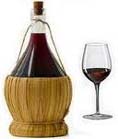Coffee Makers
from Italian Traditional Food
Types of coffee makers
Drip or filter coffee makers consist of two
containers - a jug and a top filter for the coffee grounds. Some have a centre basket/strainer (usually for
coarse-ground coffee), while others use a filter bag (usually for fine-ground coffee).
General information about coffee makers
Water just below boiling point is poured into the top container
and left to drip through. The water often has to be added in two or three doses, but new filter designs, with
larger top containers, are now on the market and take all the water in one pouring.
Metal drip machines of similar design use cold water in the bottom
compartment with coffee in the centre basket, the machine being put on the heat until the water boils, when the
machine is reversed to allow the water to filter through. The drip or filter
method takes very little time and attention and most coffee experts consider that this method produces the finest,
full-flavoured coffee, and that the type using filter bags makes a very clear coffee. Metal coffee makers can give
a metallic taste if not kept scrupulously clean.
It is easy to keep the coffee warm in most drip and filter
machines, of which there are several types on the market. Ceramic or earthenware ones can be left on a very low,
warming heat or an asbestos mat over a gas flame. One new type with a large filter has a glass "jug" lower
container which will stand higher heat.
These coffee makers come in various
sizes, from 2 -10 cup capacity. You can also buy individual filters for cups, and an automatic drip
maker.
Espresso
Espresso coffee makers are a domestic version of the Italian ones which
have made espresso coffee popular in coffee bars. They consist of two containers and a centre filter funnel, which
hold the coffee. Cold water is put in the bottom container and the machine screwed tightly together and put on the
heat. When the water reaches the right temperature, it is forced up at a high pressure through the coffee into the
top container.
Espresso machines are easy to manage and need little attention, but they must be taken off the
heat as soon as all the water has risen, otherwise the machine may be ruined (the pressure valve can burst and the
container burn).
These coffee makers are designed to extract stronger, sharper flavours and,
with the right type of roast, make a good after-dinner type coffee. The coffee will cool quickly in the top
container so, if not wanted immediately decant it into a hot jug.
Espresso machines are usually aluminium, although a stainless steel one is available. They
should be kept very clean and aired; the several small pieces need extra attention when washing. They come in all
sizes from 1 -9 cup (4 -18 demi-tasses) capacity.
Page 2 of this Italian Traditional Food article can be found on the next page.
Page 1 Next
>>

Copyright © 2009 -
. All Rights Reserved Worldwide. Italian Traditional Food
You may not reprint articles from this website
without the written permission of the site owner.
Disclaimer: Articles on this
Website are provided for information purposes only. Italiantraditionalfood.com does not accept any responsibility
or liability for the use or misuse of the article content on this site or reliance by any person on the site's
contents.
| 


 Digg
Digg Stumbleupon
Stumbleupon Google Bookmarks
Google Bookmarks Delicious
Delicious Twitter
Twitter Facebook
Facebook Yahoo My Web
Yahoo My Web Reddit
Reddit